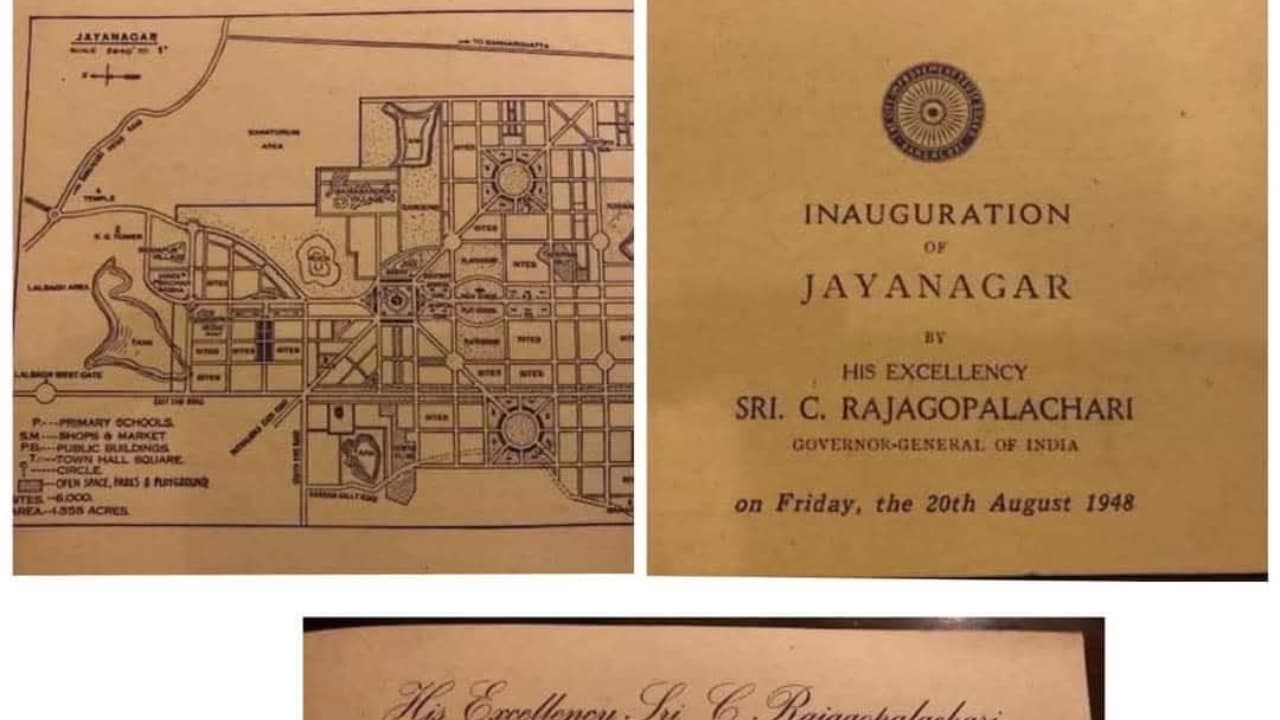MP Tejasvi Surya’s post sharing a 1948 Jayanagar inauguration invite has gone viral, sparking debate on Bengaluru’s civic decline. The historic document highlights how the city was once planned with global standards like Tokyo and London.
Bengaluru: A 1948 inauguration invitation for Jayanagar, once hailed as one of Asia’s earliest and most thoughtfully planned urban layouts, has gone viral on X (formerly Twitter), triggering a wave of nostalgia and frustration over the city’s present-day civic decline.
The invitation, shared by Bengaluru South MP Tejasvi Surya, highlighted the visionary planning and civic seriousness that once defined Bengaluru’s development. Drawing comparisons to cities such as Tokyo and London, Surya lamented how far the city has drifted from its original ethos of order, design, and dignity in urban planning.
A Declaration of Nation-Building
Sharing the historic invitation, Surya wrote: “This invitation from the history of Jayanagar’s inauguration in 1948 is a reminder of how Bengaluru went from Jayanagar’s planned blueprint to today’s maddening chaos. It wasn’t merely an inauguration. It was a declaration — that urban development was an act of nation-building.”
He explained that Jayanagar was conceived by the Bangalore City Improvement Trust Board (CITB), the precursor to today’s BDA, under the guidance of Sir M Visvesvaraya and the Mysore Maharajas. It was a model township built on principles inspired by the great cities of the world — grid-based layouts, wide tree-lined avenues, and abundant parks.
Even the decision to invite the Governor-General to inaugurate the neighbourhood symbolised the pride attached to civic progress. Urban planning was once led by engineers, architects, and visionaries, not contractors and consultants, Surya observed.
Scroll to load tweet…
A City Must Be Engineered, Not Improvised
In his post, Surya lamented how the modern city has drifted from its original planning philosophy.
“Every road had a logic. Every park had a purpose. Every design decision carried dignity. Leaders like the Maharajas and Visvesvaraya believed that cities reflected a civilisation’s discipline,” he said.
He noted that Mysore’s administrators treated city-building as an institution-building exercise, creating lasting infrastructure such as universities, dams, and townships that continue to function even after seven decades.
“Today, we live amid the ruins of that foresight,” Surya added. “Where there were walkable boulevards, we have potholes and parking chaos. Where there were civic squares, we now have encroachments and flyovers.”
The MP criticised modern political leadership for confusing construction with true development and for reducing planning agencies to “contractors’ departments”.
Surya wrote: “Our political leadership, across parties, has confused construction with development and visibility with vision. The BDA, once a planning institution, is now merely a contractor’s office.”
He cited examples of poor design and planning failures, including roads without logic, incomplete footpaths, drainage built post-monsoon, and metro alignments forced into chaotic spaces. “It’s not just inefficiency; it’s the absence of imagination,” he said.
A Mirror From History
The 1948 Jayanagar inauguration invitation, Surya said, acts as a mirror reflecting how much civic dignity the city once possessed and how little remains today.
“That single event symbolised urban governance as a national calling. Today, our cities are governed by short-termism and populism, with no professional planning cadre, no respect for design, and no accountability,” he wrote.
He urged policymakers to return to the ethos that built Jayanagar: plan before you build, design for people not vehicles, and let professionals lead instead of politicians meddling.
Urbanisation Is India’s Destiny
Concluding his post, Surya reflected on the future of India’s urban development: “Urbanisation is India’s destiny. But without leadership like the Mysuru Maharajas or Sir Visvesvaraya’s, it may also become our greatest failure.”
He called for a new generation of reformers to rebuild Bengaluru’s civic vision and restore dignity to public spaces.
How Did Social Media React?
The post ignited widespread discussion among citizens, urban planners, and civic activists, many of whom expressed both nostalgia and anger at Bengaluru’s crumbling civic state.
One user commented: “Because the last BBMP election was held in 2015 (population ~10 million), there has been no local representation for 5 years. Now the population is 14.5 million. People don’t know who to ask for accountability of civic works. Conduct BDA election ASAP.”
Scroll to load tweet…
Another user wrote: “You said it — ‘Urbanisation is India’s destiny. But without leadership like the Mysuru Maharajas or Sir Visvesvaraya’s, it may also become our greatest failure.’
Scroll to load tweet…
A third user commented: “Very well said. Just a few days back while travelling on the roads of Jayanagar, it felt tragic seeing garbage, encroachments and chaos. The least that Jayanagar should have had was pedestrian-friendly infrastructure with broad, clean footpaths. Even that is missing.”
Scroll to load tweet…
Another remarked: “Decongest the cities and spread economic zones far and wide. Controlling every aspect of urban life will strangle the world. Control the population influx from streets to workplaces. Dystopian but inevitable.”
Scroll to load tweet…
A City at a Crossroads
The viral post has reignited a long-standing debate on urban governance, civic accountability, and the erosion of planning institutions in Bengaluru. For many, Jayanagar’s 1948 inauguration invite is not just a relic of the past but a reminder of what Indian cities could have been and what they must strive to become again.
